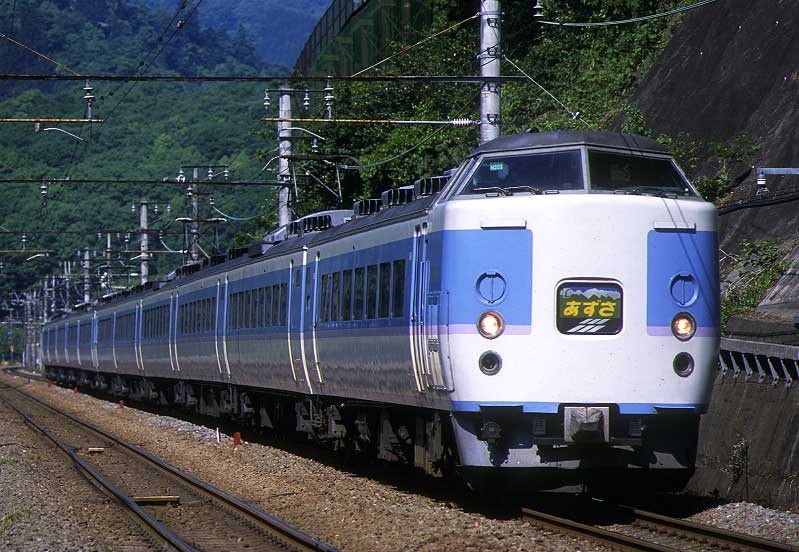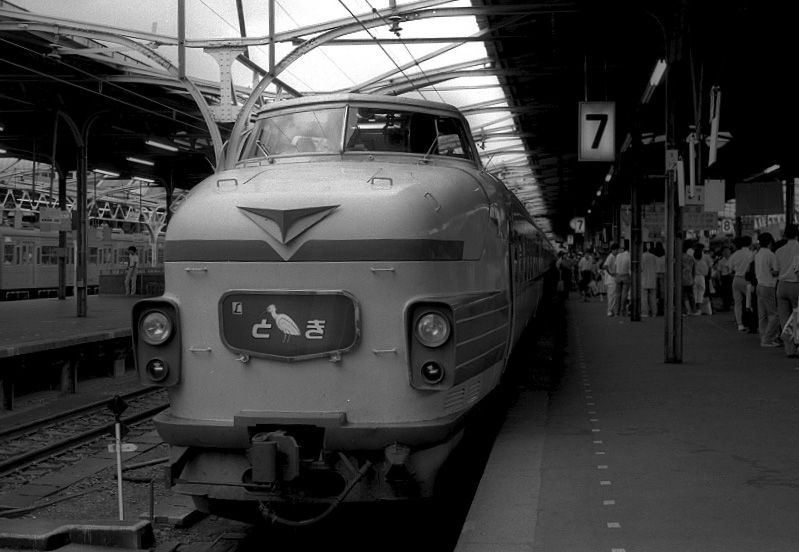|
Shiosai
The is a limited express train service in Japan operated by East Japan Railway Company (JR East). It runs from and to on the Bōsō Peninsula in Chiba Prefecture. Station stops ''Shiosai'' services operate over the Sōbu Main Line, stopping at the stations listed below. No services operate as "Local" all-stations services in any section; this characteristic is different from that of Wakashio ltd.exp.. - - - - - - - - - - * No.1 & 12 trains also stop at station. * No.2, 4 & 13 trains also stop at station. Rolling stock * 255 series 9-car EMUs (since 10 December 2005) * E257-500 series 5/10-car EMUs ''Shiosai'' services are operated using Makuhari-based 9-car 255 series EMU and 10-car E257-500 series EMU formations. The E257-500 series formations have no Green (first class) cars. Past rolling stock * 183 series EMUs (10 March 1975 – 2005) Formations Trains are formed as shown below, with car 1 at the Tokyo end. 9-car 255 series As of 2019, cars ... [...More Info...] [...Related Items...] OR: [Wikipedia] [Google] [Baidu] |
255 Series
The , branded , is a DC electric multiple unit (EMU) train type operated by East Japan Railway Company (JR East) in Japan. It was introduced into commercial service on 2 July 1993, and was specifically designed to be used limited express services from Tokyo to the Bōsō Peninsula. Design The trains were built jointly by Kinki Sharyo and Tokyu Car, with a steel body design based directly on the earlier 253 series EMUs built for ''Narita Express'' services, although the window height was increased by . It is the first JR East limited express rolling stock to feature VVVF Gate turn-off thyristor traction control systems, based on the results of trials with the prototype 209 series commuter EMUs. DT56E bogies are used on motored cars, and TR241E bogies are used on trailer cars. Operations Sōbu Main Line * ''Shiosai'': Tokyo - (since 10 December 2005) Sotobō Line * ''Wakashio'': - Tokyo * ''Shinjuku Wakashio'': Shinjuku - Formations The five 9-car sets, numbered Be01 to ... [...More Info...] [...Related Items...] OR: [Wikipedia] [Google] [Baidu] |
Sōbu Main Line
The is a Japanese railway line operated by the East Japan Railway Company (JR East) in Japan. It connects Tokyo with the east coast of Chiba Prefecture, passing through the cities of Funabashi, Chiba, and Chōshi. Its name derives from the old provinces of the area which it serves: Musashi ( ja, 武蔵国, links=no), Shimōsa ( ja, 下総国, links=no) and Kazusa ( ja, 上総国, links=no). Its official line color is navy. Definition Formally, the Sōbu Main Line refers to the line from Tokyo to . However, informally, the character of the line changes at Chiba. The more urbanized section west of Chiba is informally, but commonly, called the Sōbu Line( ja, 総武線, links=no, ) without using "Main". The "Main Line", in popular usage, refers to the more rural section east of Chiba. Route maps, signs at stations, in trains, and the vocal announcements all maintain this distinction: ''with Main'' for the eastern rural section; ''without Main'' for the western frequent travel ... [...More Info...] [...Related Items...] OR: [Wikipedia] [Google] [Baidu] |
E257 Series
The is a DC electric multiple unit (EMU) train type operated in Japan for limited express services by East Japan Railway Company (JR East) and built jointly by Hitachi, Kinki Sharyo, and Tokyu Car Corporation. Variants * E257-0 series: ''Azusa'', '' Kaiji'' * E257-500 series: '' Sazanami'', ''Wakashio'', ''Shiosai'', '' Ayame'' * E257-2000/-2500 series: ''Odoriko'', ''Shōnan'' *E257-5000/-5500 series: additional services Four variants exist: the original E257-0 series for use on Chūō Main Line ''Azusa'' and '' Kaiji'' limited-express services until 16 March 2019 (displaced by E353 series EMUs), the E257-500 series for use on Chiba area limited express services ( Uchibo Line '' Sazanami'', Sotobo Line ''Wakashio'', Sōbu Main Line ''Shiosai'', and Narita and Kashima Lines '' Ayame''), the E257-2000/-2500 used for ''Odoriko'' services modified from former E257-0 and -500 series trains, and the E257-5000/5500 from former E257-0 and -500 trains for use on additional and cha ... [...More Info...] [...Related Items...] OR: [Wikipedia] [Google] [Baidu] |
183 Series
The was a Japanese limited express electric multiple unit (EMU) train type introduced in 1972 by Japanese National Railways (JNR). Following the privatization of JNR, the 183 series was operated by East Japan Railway Company (JR East) and West Japan Railway Company (JR-West). In terms of design, it is closely based on the late-model AC/DC 485 series, with minor cosmetic differences and DC-only drive. The last 189 series sets were withdrawn on 29 March 2019. The trains were built by Hitachi, Kawasaki Heavy Industries, Kinki Sharyo, Nippon Sharyo, and Tokyu Car Corporation. Former operations JR East * ''Azusa'' (seasonal only) * '' Kaiji'' (seasonal only) * ''Wing'' * ''Moonlight Shinshū'' * ''Moonlight Nagara'' * '' Sazanami'' * ''Wakashio'' * ''Shiosai'' * '' Ayame'' * '' Suigo'' * '' Toki'' * '' Amagi'' * ''Odoriko'' * '' Asama'' * '' Myōkō'' * '' Ohayō Liner'' * '' Chūō Liner'' (until March 2008) * '' Ōme Liner'' (until June 2002) JR-West The 183 series trains ope ... [...More Info...] [...Related Items...] OR: [Wikipedia] [Google] [Baidu] |
JR East
The is a major passenger railway company in Japan and is the largest of the seven Japan Railways Group companies. The company name is officially abbreviated as JR-EAST or JR East in English, and as in Japanese. The company's headquarters are in Yoyogi, Shibuya, Tokyo, and next to the Shinjuku Station. It is listed in the Tokyo Stock Exchange (it formerly had secondary listings in the Nagoya and Osaka stock exchanges), is a constituent of the TOPIX Large70 index, and is also one of the three only Japan Railways Group constituents of the Nikkei 225 index, the other being JR Central and JR West. History JR East was incorporated on 1 April 1987 after being spun off from the government-run Japanese National Railways (JNR). The spin-off was nominally "privatization", as the company was actually a wholly owned subsidiary of the government-owned JNR Settlement Corporation for several years, and was not completely sold to the public until 2002. Following the breakup, JR East ... [...More Info...] [...Related Items...] OR: [Wikipedia] [Google] [Baidu] |
List Of Named Passenger Trains Of Japan
This article contains lists of named passenger trains in Japan. Shinkansen (bullet trains) Daytime trains Limited express (partial list) Express Rapid Night trains Limited express Express Rapid See also * Rail transport in Japan References * JR Timetable, December 2008 * * {{reflist List of named passenger trains of Japan Japan Japan ( ja, 日本, or , and formally , ''Nihonkoku'') is an island country in East Asia. It is situated in the northwest Pacific Ocean, and is bordered on the west by the Sea of Japan, while extending from the Sea of Okhotsk in the north ... Named passenger trains ... [...More Info...] [...Related Items...] OR: [Wikipedia] [Google] [Baidu] |
East Japan Railway Company
The is a major passenger railway company in Japan and is the largest of the seven Japan Railways Group companies. The company name is officially abbreviated as JR-EAST or JR East in English, and as in Japanese. The company's headquarters are in Yoyogi, Shibuya, Tokyo, and next to the Shinjuku Station. It is listed in the Tokyo Stock Exchange (it formerly had secondary listings in the Nagoya Stock Exchange, Nagoya and Osaka Exchange, Osaka stock exchanges), is a constituent of the TOPIX Large70 index, and is also one of the three only Japan Railways Group constituents of the Nikkei 225 index, the other being Central Japan Railway Company, JR Central and West Japan Railway Company, JR West. History JR East was incorporated on 1 April 1987 after being spun off from the government-run Japanese National Railways (JNR). The spin-off was nominally "privatization", as the company was actually a wholly owned subsidiary of the government-owned Japanese National Railway Settlement ... [...More Info...] [...Related Items...] OR: [Wikipedia] [Google] [Baidu] |
Limited Express
A limited express is a type of express train service. It refers to an express service that stops at a limited number of stops in comparison to other express services on the same or similar routes. Japan The term "limited express" is a common translation of the Japanese compound noun ; literally "special express"; often abbreviated as . Although some operators translate the word differently, this section is about ''tokubetsu kyūkō'' trains in Japan regardless of the translation by the operators. This term also includes terms with ''limited express'' in them, such as . There are two types of limited express trains: intercity and commuter. The former type of limited express trains generally use long-distance coaches, equipped better than other ordinary express trains, including reserved seating, dining cars or food and beverage carts, and "green cars" (first class cars). The latter type of limited express train usually incurs no surcharge, but seating is usually first-come, f ... [...More Info...] [...Related Items...] OR: [Wikipedia] [Google] [Baidu] |
Toki (train)
The is a high-speed Shinkansen train service operated by East Japan Railway Company (JR East) on the Joetsu Shinkansen in Japan. The name is taken from the Japanese name of the crested ibis, for which Niigata is famous. Station Stops * * * * * * * * * * * * * * * * * * * * * (*) Not served by all trains Rolling stock * E2 series 10-car sets (from 26 January 2013) * E7 series 12-car sets (''Toki'') (from 3 March 2019) File:E2 J63 omiya.JPG, An E2 series set File:Series-E7-F21.jpg, An E7 series set Former rolling stock * E1 series 12-car sets (''Max Toki'') (until 28 September 2012) * 200 series 10-car sets "K" sets (until 15 March 2013) * E4 series 8-car sets (''Max Toki'') (until 1 October 2021) File:JR East Shinkansen E1(renewal).jpg, A refurbished E1 series set File:JNR200-K51.jpg, A refurbished 200 series set File:Series-E4-P20.jpg, A refurbished E4 series set History Limited express The name ''Toki'' was first introduced on 10 June 1962 for limited express ... [...More Info...] [...Related Items...] OR: [Wikipedia] [Google] [Baidu] |
JRE 165-revival Train Inubou
*Jeunes Restaurateurs d’Europe
{{disambig ...
The Joe Rogan Experience (JRE) is a podcast hosted by American comedian and presenter Joe Rogan. JRE can also mean: *Java Runtime Environment *The Joe Rogan Experience *JR East, see East Japan Railway Company The is a major passenger railway company in Japan and is the largest of the seven Japan Railways Group companies. The company name is officially abbreviated as JR-EAST or JR East in English, and as in Japanese. The company's headquarters are ... [...More Info...] [...Related Items...] OR: [Wikipedia] [Google] [Baidu] |
Naruto Station With Shiosai May2005
''Naruto'' is a Japanese manga series written and illustrated by Masashi Kishimoto. It tells the story of Naruto Uzumaki, a young ninja who seeks recognition from his peers and dreams of becoming the Hokage, the leader of his village. The story is told in two parts – the first set in Naruto's pre-teen years, and the second in his teens. The series is based on two one-shot manga by Kishimoto: ''Karakuri'' (1995), which earned Kishimoto an honorable mention in Shueisha's monthly ''Hop Step Award'' the following year, and ''Naruto'' (1997). ''Naruto'' was serialized in Shueisha's magazine, ''Weekly Shōnen Jump'' from 1999 to 2014, and released in ''tankōbon'' (book) form in 72 volumes. The manga was adapted into an anime television series produced by Pierrot and Aniplex, which broadcast 220 episodes in Japan from 2002 to 2007; the English dub of the series aired on Cartoon Network and YTV from 2005 to 2009. '' Naruto: Shippuden'', a sequel to the original series, pr ... [...More Info...] [...Related Items...] OR: [Wikipedia] [Google] [Baidu] |



